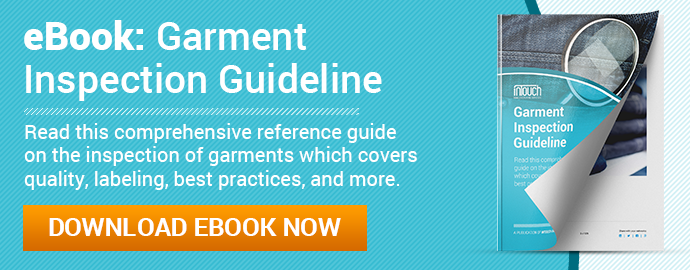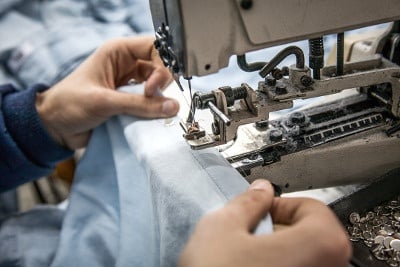 When shopping for clothes, the typical consumer notices several more obvious features, like buttons, fabric type & feel, and overall design. But one relatively subtle area that deserves special attention is the stitching. And most professionals working in the garment industry take great pains to ensure the right sewing techniques are used in mass production.
When shopping for clothes, the typical consumer notices several more obvious features, like buttons, fabric type & feel, and overall design. But one relatively subtle area that deserves special attention is the stitching. And most professionals working in the garment industry take great pains to ensure the right sewing techniques are used in mass production.
They may be small, but stitches are an important consideration when importing or manufacturing garments. Different sewing stitches for clothing offer their own advantages and disadvantages. Some stitches are better suited for style and decoration, for example. Others are more durable and suited for different applications. And certain techniques consume more thread or take longer to weave, which can impact costs and manufacturing lead times.
Understanding the stitches used in manufacturing can help you make an informed decision about which are best for your next order of garments. Let’s unravel the mystery behind common stitches and examine their pros and cons.
Properties of sewing stitches in manufacturing
Before we look at specific stitches, it’s important to understand how to evaluate them so you can oversee exactly what you want in your garments. When designing or inspecting a garment, your analysis of seams and stitches should include stitches per inch, seam strength and the size, consistency and tension of the stitches. You’ll want to factor these properties of different stitching techniques into the design of your garment, depending on how it’s meant to be worn and used.
Stitches per inch
Looking at a garment—or an order of garments—you can form a rough idea of the length and quality of its stitching by 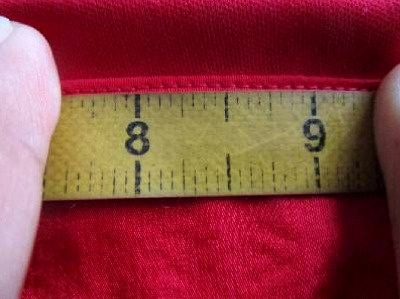 noting its stitches per inch (SPI). A higher SPI indicates greater stitch density and often higher quality stitching. More short stitches typically mean there are stronger connections at the seams. In some cases, more decorative designs also call for a higher SPI.
noting its stitches per inch (SPI). A higher SPI indicates greater stitch density and often higher quality stitching. More short stitches typically mean there are stronger connections at the seams. In some cases, more decorative designs also call for a higher SPI.
Conversely, a lower SPI often indicates lower quality. Garments with a low SPI are typically less durable, have long stitches and are more prone to snagging. The main advantage of a low SPI in garments is that sewing requires less thread. As a result, it’s often faster and less expensive to produce garments with a lower SPI. A garment with a higher SPI will typically be more time and thread intensive, which can increase your manufacturing costs.
Stitch width, depth, consistency and tension
Aside from the indications of length that SPI offers, garment manufacturers should also consider stitch width and depth. Stitch width is the distance between the lines of the outermost parts of the stitches. Stitch depth is the distance between a stitch’s upper and lower surfaces.
Stitch consistency is the regularity of how each stitch is formed in a row of stitches and is important not only for the structural integrity of a garment, but also for its appearance. Consistency is a highly valued quality in luxury garments. When a factory worker makes a mistake stitching a garment, that irregularity can also cause a weak point in the seam of the garment.
Thread tension is the balance of force on the threads that eventually form the stitch. Too much tension can cause seam puckering, unbalanced stitch formation and uneven stitches. Too little tension can leave you with loose, uneven stitches and excessive looping. Without the right amount of tension, seams can become misshapen or susceptible to unraveling.
Seam strength
Together, these properties contribute to seam strength in a garment. SPI, specifically, is used in formulas for common stitches to determine how much force a seam can resist before breaking. This knowledge is important because it allows for pass-fail testing of your garments during inspection based on quantitative measurements.
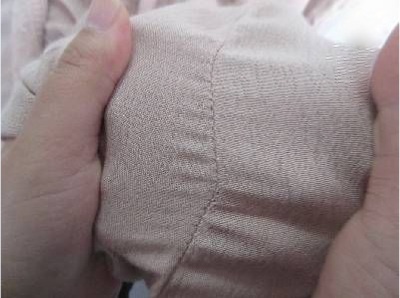 The estimated seam strength formulas for two common sewing stitches used in manufacturing are:
The estimated seam strength formulas for two common sewing stitches used in manufacturing are:
Multithread chain stitch: SPI x thread strength (lbs) x 1.7 = seam strength (lbs)
Lockstitch: SPI x thread strength (lbs) x 1.5 = seam strength (lbs)
You can incorporate the seam strength you want into your garment design by using this formula.
You may not need high seam strength in a silk scarf, for example. But greater seam strength is usually very important to the functionality of construction work gloves. Whatever clothing you’re manufacturing, it helps to have an idea of your desired stitching properties and seam strength so that your garments meet customer expectations.
4 common sewing stitches used in garment manufacturing
Considering the wide variety of stitches used in garment manufacturing, the American Society for Testing and Materials (ASTM) created a taxonomy for them known as ASTM D 6193. The International Organization for Standardization (ISO) also has a classification system, ISO 4915:1991. Throughout the remainder of this article, we’ll refer to ASTM’s grouping.
Each general stich type is classified as class “100”, “200”, “300" and so on. Variations of these stitch types are further distinguished by digit endings within that group. For example, lock stitches are the class 300 category. A class “304” stitch refers to a zigzag lockstitch. Sometimes thread count separates these stiches and, in other cases, style. No matter the difference, by using these standard industry specifications, it becomes much easier to communicate with factories and designers about your stitching needs.
1. Chain stitch
The chain stitch falls into class 100 and is created when two or more sets of threads come together in a chain-like pattern. One or more needle threads penetrate the material being used and form a loop underneath it. Chain stitching is used frequently on decorative parts of clothing or anywhere else that needs an aesthetic touch-up. When sewn properly,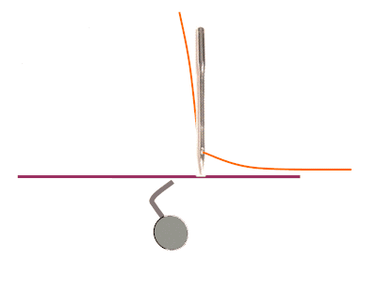 it can leave an ornate, thick and textured line.
it can leave an ornate, thick and textured line.
Since it’s slightly larger than other stitch types, the chain stitch is also effective at filling up space in garments. The chain stitch has a nice-looking “roping” effect, which can lend to a better fading pattern where it’s used.
But the beauty of chain stitches often comes at a cost. This stitching type uses more thread and, while more aesthetically pleasing, isn’t as strong as others. Seams joined with chain stitching often unravel easier. And the amount of extra sewing time for garments where chain stitching is used can add up, making this stitching type more laborious than others. These are important traits to consider when choosing to use chain stitching in garment manufacturing.
2. Multithread chain stitch
The multithread chain stitch, or double locked chain stitch, falls into class 400. It’s formed when one or more needle threads move through the fabric and inter-loop with a group of looping threads on the underside of the garment. The resulting stitch looks different on the top and bottom of fabric.
While it may appear similar to a standard chain stitch, it’s distinguished by its strength, durability and how it elongates better when extended. It can be used for elastic in waistbands, jackets, blazers, T-shirts, decorative stitching on belts and more. When sewn correctly, the multithread chain stitch is less vulnerable to seam puckering because it’s located underneath the fabric rather than between its layers.
Some clear disadvantages exist with the multithread chain stitch. It consumes more thread and generally takes longer to sew, depending on the skill of workers and the quality of equipment they’re using. And if a thread is damaged, the stitch can unravel easily, which might threaten the integrity of an entire seam. Many garment manufacturers prevent this by over-sewing or bar-tacking the seam for added reinforcement.
3. Lockstitch
Also known as single needle stitching, the class 300 lockstitch is made when two threads lock together at minor 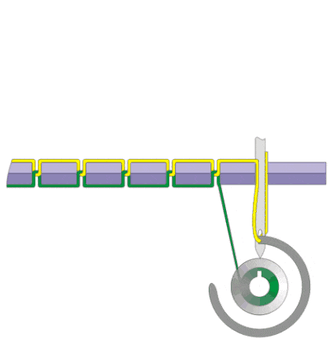 intervals. It’s the result of a rotary hook catching a needle thread loop as it goes around the bobbin and interlocks two threads.
intervals. It’s the result of a rotary hook catching a needle thread loop as it goes around the bobbin and interlocks two threads.
This stitch is very common as it’s one of the fastest and cheapest to sew. On the inside and outside of the garment, this stitch will appear the same, whereas a chain stitch and multithread chain stitch will vary in these two areas. The lockstitch can become very tight, such as the 301 twin needle lockstitch. So it’s typically not suitable for knit and elastic fabrics that need flexibility.
Not all lockstitches are appropriate for the same purposes. Some classes of lockstitches, like 313 and 314, are good for dress slacks and waistbands. Others, like the 304 zigzag lockstitch, are more appropriate for decorative stitching or particular parts of athletic wear. The suitability of a certain lockstitch for a garment depends on the stitching properties a customer requires.
4. Overlock stitch
The class 500 overlock stitch goes by many other names, including overedge, overlock, serge, overcast or merrow. It’s typically used in over-sewing, the sewing technique of creating a stitch over the edge of cut fabric. One group of thread goes around the edge of the fabric so that the threads from it are contained, which typically reinforces the inner stitching.
By choosing anywhere from one to five threads, the overlock stitch significantly changes in use:
- Class 501, one thread: end-to-end seaming and hems
- Class 502-504, two to three threads: edging and seaming
- Four threads: mock safety stitches that are strong and flexible
- Five threads: very strong safety stitches
The overlock stitch is relatively flexible and often used for edge neatening of knitted fabrics. It’s a popular choice among manufacturers of sportswear, dance clothing, spandex and other garments and materials that needs to stretch. Aside from these applications, the stitch is also used on the edge of garments for added aesthetics and to prevent fraying.
On the negative side, the overlock stitch is known for its very high thread consumption. But despite needing more thread for overlock stitches, overlock stitching machines are typically able to sew garments faster than other common sewing techniques.
Conclusion
The fabric and design you select aren’t the only choices to consider when making clothing. Stitches play a vital role not just in seam strength, flexibility and appearance, but also in the length of sewing cycles and cost of manufacturing.
Some situations may call for lockstitches. In others, a combination of overlock stitches and lockstitches are necessary. Whatever the combination, these decisions and your desired stitching properties will ultimately affect the quality and cost of your order.
By knowing these four common stitches and how to evaluate each, you’ll be able to examine your garments with greater scrutiny during product inspection at the factory. You’ll also be in a better position to follow the latest fashion trends and give your customers the products they want. Finally, this gives you greater control over the product to prevent quality issues.
What sewing techniques do you prefer in the garments you design, produce or source and why? Let us know in the comments below!
